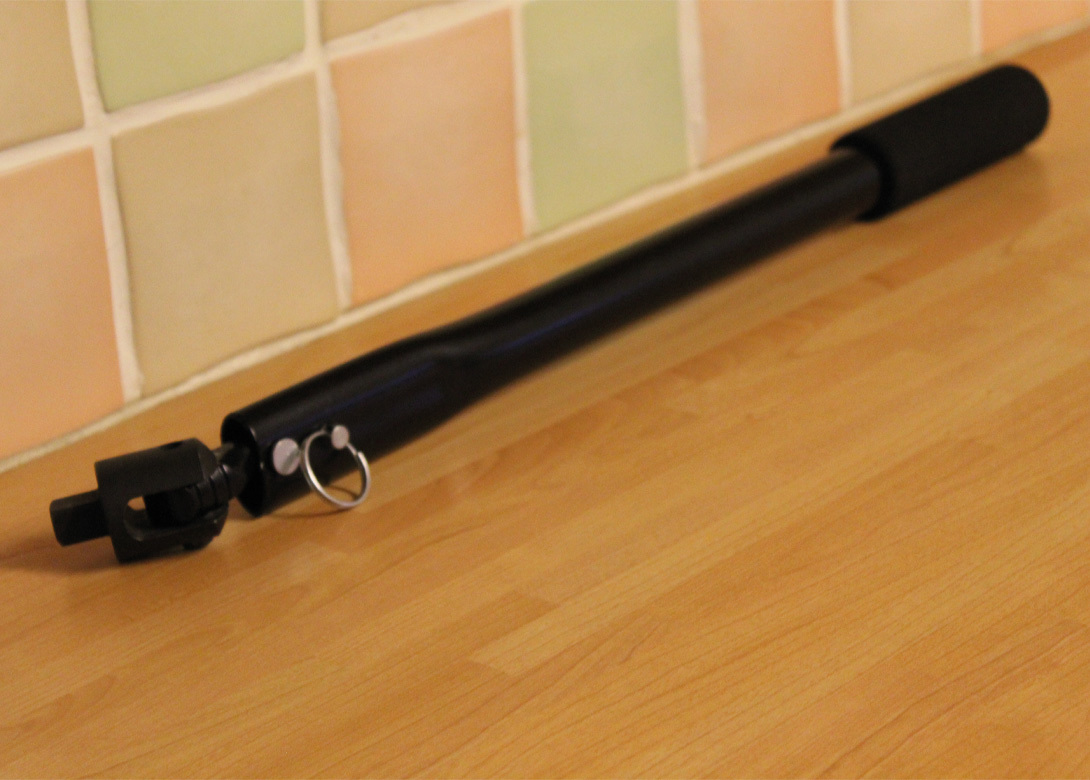
After announcing the creation of JoltWrench in 2020 – a breaker bar that can transform into a high torque impact wrench – Inventor Mick Carrington has confirmed the JoltWrench has received a full patent.
Approximately five years ago, after the creation of a very crude working prototype of the JoltWrench innovative spanner, Mick had an opportunity to prove the concept when he was presented with three seized solid studs on his exhaust front pipes to the manifold on his old Camaro. “I was considering trying to get an oxyacetylene torch into the tight gap between engine and bulkhead, when I tried the JoltWrench prototype and it worked perfectly,” says Mick.
The JoltWrench is fundamentally a breaker bar that can be changed into a high torque impact wrench for those having trouble loosening a nut or bolt because they are overtightened or seized due to rust. “The transformation from a breaker bar to a wrench is straight forward, with the user simply removing a ring pull pin – changing the JoltWrench into a vital spanner for those awkward situations, before having to resort to the grinder or burning gear,” explains Mick. “The JoltWrench then provides a quick and easy tightening of a nut or bolt, without the need for overly long, dangerous and often ill-fitting extension bars – making full use of Newtons 2nd Law of Motion: Force equals mass times by acceleration.”
Mick’s initial success with the JoltWrench spurred him on to making a ‘better looking’ prototype, which he then showcased to a UK retailer of car and cycling products and services, which duly led to them offering a contract. “Unfortunately, the Covid-19 pandemic then hit and caused my progress with the JoltWrench to stop in its tracks,” points out Mick. “Instead I used this time to look into finding a way forward, and it appeared that although the UK retailer was a well-known and respected British company, they would only be selling to the UK in their stores – thus cutting out the worldwide sales that I had in my sights. We didn’t agree on the contractual limits laid out, and so I was again looking for a partner willing to help out with manufacture – in order to supply a potential massive customer base.”
Mick continues: “I had an article published in Fastener + Fixing Magazine in September 2020 and it caused some interest around the world and I had a Zoom meeting with Mr Black of Blacks Fasteners in New Zealand, who made the sage comment that the spanner didn’t look very “sexy”, but he did order 50 items if I had it manufactured in order to try the sales out. I also had interest from Germany, and the USA, but couldn’t follow through with sales because I hadn’t got a manufacturer involved. As most countries were locked down it became impossible to have meetings to demonstrate my spanner and, frustratingly, I could only make appointments to meet after the pandemic.”
These hold ups didn’t stop Mick trying to move forward and instead he used the time to make additional prototypes and even managed to get one into a working garage to monitor performance – with the tool working flawlessly for three months.
“Although the design I was using was very strong and durable, as I was making it out of laminated mild steel – which enabled me to weld it together without the use of expensive machinery, I couldn’t get any sensible quotations for manufacture in the UK,” highlights Mick. “This made it impractical and expensive to produce myself.”
He continues: “When I came up with the original idea I had two versions, both of which achieved the same effect of multiplying torque, and my mind went back to Roger Blacks’ comment about the spanners drab looks. This spurred me on to trying to produce a new design prototype that looks professional, as it uses a tube as a base handle – which allowed me to utilise a weight in the end that can also be increased by the removal of an access plug – with the mechanism contained in the other end. I am also working with Derby University to help calculate the torque forces involved, so we can work out what materials to use to best withstand the forces and be safe in operation, etc. This design is simple and uses inexpensive parts, and so I am again seeking a manufacturing partner to help take this newly patented product to market.”
Mick concludes: “As this spanner has helped me out with my car restoration and maintenance, as well as proved itself within a working garage, I’m sure it will be a welcome and safer addition to all home mechanics and a useful backup tool for the professionals – as it doesn’t need a battery and can always be on hand, ready to use.”

Will joined Fastener + Fixing Magazine in 2007 and over the last 12 years has experienced every facet of the fastener sector – interviewing key figures within the industry and visiting leading companies and exhibitions around the globe. Will manages the content strategy across all platforms and is the guardian for the high editorial standards that the brand is renowned.
Don't have an account? Sign Up
Signing up to FastFixTechnology.com enables you to manage your account details.